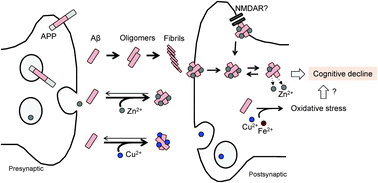Is interaction of amyloid β-peptides with metals involved in cognitive activity?
Abstract
Metal ions, i.e., Zn2+ and Cu2+, are released from neuron terminals in the hippocampus, which plays important roles in spatial and declarative memory, and may serve as a signal factor. Synaptic homeostasis of metal ions is critical for cognitive activity in the hippocampus. Amyloid-β (Aβ) is a causative candidate for the pathogenesis of Alzheimer's disease (AD) and Aβ-induced synapse dysfunction is easy to emerge along with normal aging and leads to the cognitive decline and memory loss in the pre-dementia stage of AD. Because Aβ interacts with Zn2+ and Cu2+, it is likely that these metal ions are involved in the Aβ-induced modification of the synaptic function. There is evidence to indicate that the inhibition of the interaction of Aβ with Zn2+ and Cu2+ may ameliorate the pathophysiology of AD. Interaction of extracellular Zn2+ with Aβ in the hippocampus is involved in transiently Aβ-induced cognition deficits, while the interaction of extracellular Cu2+ reduces bioavailability of intracellular Cu2+, followed by an increase in oxidative stress, which may lead to cognitive deficits. It is likely that Zn2+ and Cu2+ play as a key-mediating factor in pathophysiology of the synaptic dysfunction in which Aβ is involved. Based on the idea that understating Aβ-induced changes in synaptic plasticity is important to prevent AD, the present paper summarizes the interaction of Aβ with metal ions in cognition.

- This article is part of the themed collection: Alzheimer's Research Month 2016

 Please wait while we load your content...
Please wait while we load your content...